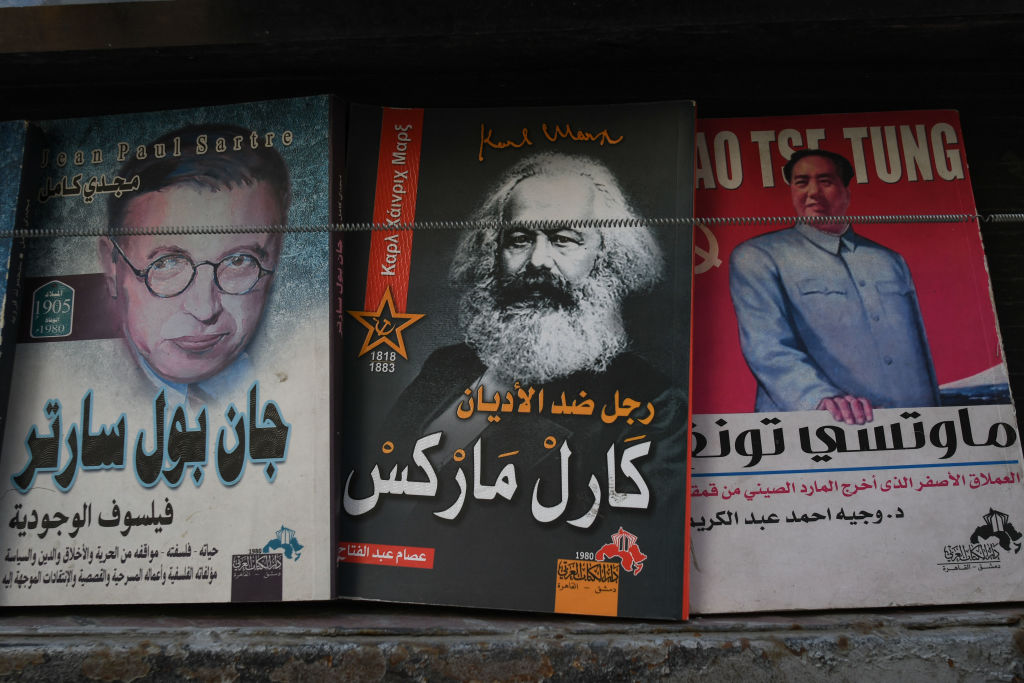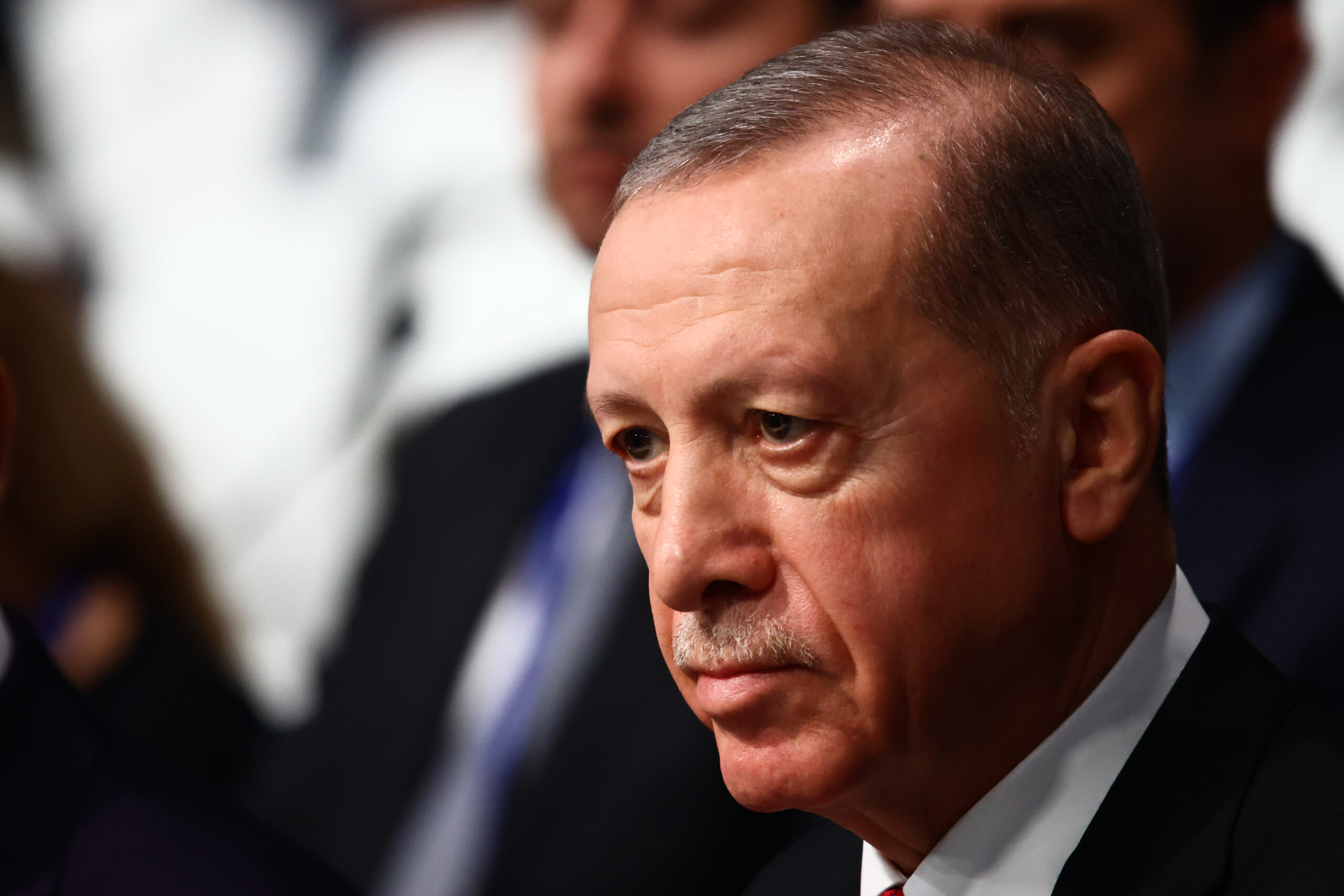Hamas is a less significant existential threat than the collapse of U.S. leadership.
Marx in the Middle East

Israel, Hamas, and the fracturing of the American Left.
Paul Gottfried has observed that the “leftist alliance is inherently unstable because—outside of hatred, pompous virtue-signaling, and a desire for power—exceedingly little holds it together.” In itself, this observation is not original to Gottfried, but it’s hard to find a more emphatic display of its truth than in the fissures that have erupted in the American Left since Hamas attacked Israel on October 7 and Israel began its response. The conflict has emphasized a deep divide in the American Left, one that cannot be ignored any longer under the conditions generated by the war. It reveals much about the movement.
In early October, shortly after the conflict began, the Biden Administration seemed eager to position itself squarely behind Israel. Biden joined with other Western heads of government in condemning Hamas’s actions. Almost simultaneously, Biden asserted that “In this moment, we must be crystal clear…. We stand with Israel. We stand with Israel.” The White House immediately requested an additional $2 billion in aid to Israel, and by October 20 that amount had ballooned to $14 billion.
All this is of a piece with precedents set by previous leaders of the Democratic establishment, which despite its criticisms of America’s war machine (and America more generally) has always had good reason to signal emphatic support for Israel. Biden apparently wants to do the same, yet as the war unfolds his enthusiasm has become more measured and included “words of caution.” The Associated Press reports that he “faces scrutiny from people in the younger and more liberal wing of his Democratic Party, who are more divided over the Israel-Palestinian issue than the party’s centrist and older leaders.” Members of Congress and figures within his administration are pressing Biden for a more ambivalent approach.
But if Democrats in Washington have expressed hesitancy over Biden’s support for Israel, their reservations are tame compared with the militancy of their more radical and younger peers. The activist Left has been stridently, even violently, pro-Hamas. At Harvard University, 31 student groups signed a declaration holding Israel “entirely responsible” for Hamas’s attack and its aftermath, while more than 100 Harvard faculty members condemned the university’s president for opposing antisemitism on campus. Time magazine has noticed that “Instead of condemning and mourning the deadliest day for Jews since Israel’s founding, factions of the grassroots left appeared to celebrate the assault as an act of Palestinian heroism.”
Antisemitism and the American Left
So what gives on the Left?
This question now haunts at least some American Jews, who have been among the Democratic Party’s most loyal constituencies. In 2018, CNN found that 79 percent of Jews voted Democratic in U.S. House elections that year. According to Pew Research in 2021, 71 percent of American Jews identified with or leaned toward the Democratic Party, versus only 26 percent for the Republican Party. In the 2022 midterms, 74 percent of Jews voted Democratic, against 25 percent Republican. Against a background of this support, the Left’s turn against Israel has come as a profound shock to at least some American Jews. One was reported in the Los Angeles Times as saying, “The left in America has really let us down.”
The Left’s response to the Israel-Hamas conflict has made clear that the Left has a serious antisemitism problem. Arle Periger of the University of Massachusetts, Lowell has demonstrated that “In the U.S., our data shows that 95% of antisemitic incidents motivated by Israel’s policies were perpetrated by far-left or unidentified activists. Just 5% were perpetrated by known far-right activists.” Moreover, Periger maintains that “We find that antisemitic hate crimes are occurring especially in politically progressive areas of the country.” This reality is a long way from the established narrative on antisemitism in America, which tends to associate Jew-hatred with the literati’s favorite boogieman, the far-right nationalist.
The larger question is: “why?” Why would the American Left so flagrantly betray such a core part of their coalition? To understand the answer, it becomes critical to recognize the American Left as a fundamentally and openly Marxist movement.
It was not always so. The Democratic Party was once led by men like Harry S. Truman and John F. Kennedy, both stalwart anti-Communists. Yet while Marxism as an economic doctrine famously failed to reshape America, Marxism as a cultural doctrine has penetrated deeply into the fabric of American life—in particular American liberalism, which was transformed by the New Left in the 1960s and 1970s. The New Left drew upon the work of Marxist philosophers like the Italian Antonio Gramsci, and the German-American émigré Herbert Marcuse, whom the Heritage Foundation describes as a “guru” for intellectual activists of the New Left. The influence of Marcuse and Gramsci helps explain why vanguard leftists like BLM co-founder and nudist body-paint wearing con artist Patrisse Cullors could declare openly that she and her compeers are “trained Marxists.”
But, as has been well documented, the American Left’s particular brand of Marxism is not especially interested in the traditional Marxist framework of economic struggle between bourgeois capitalists and proletarian workers (which may help explain why traditional labor-socialists like Senator Bernie Sanders have been increasingly sidelined). Instead, this Marxism is “cultural”: it seeks to take the basic methodology of Marxism and apply it in other ways. The second-wave feminist Shulamith Firestone demonstrated how this might work in The Dialectic of Sex, where she posited men and women as the struggling classes. Firestone maintained that “we can learn a lot from Marx and Engels: Not their literal opinions about women—but rather their analytical method.”
In these struggles between privileged and oppressed, the oppressed person or group always occupies a position of moral superiority, and the responsibility of members of the oppressor class who have been awakened (or become “woke”) to the realities of privilege and oppression is to ally themselves with the oppressed and affirm their perceptions of their own oppression. With so many overlapping privilege structures in a society like America, this can get messy—hence the need for the study of intersectionality to determine where people and groups fall on the scale of privilege and oppression in relation to each other.
Colonizers and Colonized
Once freed from the constraints of orthodox economic class struggle à la vintage Marx, the analytic framework can be applied along a myriad of axes: not just sex, but race, sexual orientation, and gender identity can constitute fault lines in the cultural class struggle. In books like The Wretched of the Earth and A Dying Colonialism, the Martinican Marxist theorist Frantz Fanon applied this framework to colonization, with European colonizers as the oppressor class, and the native peoples of colonized lands as the oppressed. Fanon argued that the struggle between colonist and colonized is a Manichaean struggle between one’s own people and the “other.” The colonizers systematically attempt to deprive the colonized, not merely of their land and power, but of their identity. The colonizers are always the destroyers, always the aggressors.
The basic framework for this analysis was laid long before Fanon, however, by none other than Lenin himself. Lenin argued that anything an oppressed people does to its oppressor is defensive and therefore justified as resistance to oppression. As he wrote in “The Principles of Socialism and the War of 1914-1915,” the license of the oppressed to unrestrained violence belongs to colonized peoples as well as industrial proletariats “irrespective of who attacked first; and every Socialist would sympathize with the victory of the oppressed, dependent, unequal states against the oppressing, slave-owning, predatory ‘great’ powers.” What might normally be termed offensive or aggressive war is rendered defensive because the oppressed are defending themselves against their oppressors. Even outright brutality is justified: the mere fact that these systems of oppression exist and operate constitutes outright brutality against the oppressed.
The line from Soviet-era theory to the current Marxist position on Israel is a direct one. Antisemitism on today’s Left is a legacy of the larger struggle between freedom and Communism in the second half of the twentieth century. The Soviet Union initially supported the establishment of the State of Israel in 1948, but relations between the two nations quickly began to sour as Israel increasingly aligned itself with the West. This prompted Moscow not only to change its attitude toward Israel, but also to begin to persecute Jews within its own borders. Simultaneously, the Soviet Union began to develop relationships with Israel’s Arab and Muslim neighbors, allying themselves with Egypt and Syria, and providing them with both advanced weapons and diplomatic support.
Consequently, it was entirely natural for the Soviet Union to apply the narrative of colonizer and colonized to the Arab-Israeli conflict. The State of Israel was depicted as racist, bourgeois nationalist, and colonialist, which terms define the way the modern American Left views Israel. Consciously or not, then, the American Left is following through on Moscow’s position on Israel.
A Revolution Among Revolutionaries
The implications for today’s Middle East are clear. The modern Jewish state, in this narrative, was primarily the result of two factors. First, the growth of Zionism among Western Jews with its central demand for a Jewish homeland. Second, the British Empire’s promise, embodied in the Balfour Declaration, to “favour the establishment in Palestine of a national home for the Jewish people.” So the British Empire, the very symbol of white imperialist colonialism, promised to back the colonization of Palestine by non-native people, who would eventually establish a Jewish state in 1948, with the support of the United Nations. The Israelis are thus the oppressors, the colonizers—the villains.
Conversely, the Palestinians are the oppressed. They represent the vast majority that was occupied and dispossessed; their land is now controlled by someone else, while large numbers of them went into exile. No matter that this oversimplifies centuries of complicated history: to do so is part and parcel of the Marxist analytic method. Everything must be twisted and manipulated on the procrustean bed of oppression until it fits into the narrative of binary struggle between the privileged and the dispossessed. The simplicity of the narrative is also what makes it so powerful.
As a colonized people struggling for liberation, the Palestinians are granted justification for any action they might undertake against the Israelis. Any atrocity committed by Hamas is legitimate, as it is an expression of the desire to decolonize Palestine. And since Israel is a Jewish state, and the Jewish people are the colonizers, the rationale extends to any action taken against any Jew, anywhere. One’s status as an oppressor is determined by his group identity. Just as whites and men are racist and sexist simply because they are white or male, all Jews are oppressors in the eyes of the Marxist Left because they are part of a group that has colonized Palestine. It is therefore perfectly acceptable for teenagers at a school in New York City to terrorize a Jewish teacher. Conversely, anything Israel does in its own defense is by definition illegitimate, because Israel is an oppressive colonizer.
The fact that American Jews have been reliably left-wing in their politics, as noted above, is irrelevant. The fact that prominent left-wing American Jewish intellectuals have done much to propagate this Marxist framework, and have endeavored to distinguish themselves from the hated white oppressors, is irrelevant. Books in this genre include Barbara Applebaum, Being White, Being Good; Judith H. Katz, White Awareness; Paula Rothenburg, White Privilege; George Lipsitz, The Possessive Investment in Whiteness; Maurice Berger, White Lies; Nancy Isenberg, White Trash; Michael Kimmel, Angry White Men; Jonathan Metzel, Dying of Whiteness. But all these efforts to preserve American fellow travelers from becoming the scapegoats in their own victimology have failed. White or not, American or not, Democrat or not, Jews in the view of the Marxist Left are now oppressors. The revolution eats its own.
Once we accept that the American Left are revolutionary Marxists, the tensions among modern Democrats become intelligible. Accepting this, however, is the hurdle for many Americans, as it compels us to come to grips with the reality of our own situation. In years to come, as the old guard of Biden’s generation passes away and the fervid new politics of Rashida Tlaib and Ilhan Omar takes center stage, it will only be more imperative to recognize the Marxist Left for what it is.
The American Mind presents a range of perspectives. Views are writers’ own and do not necessarily represent those of The Claremont Institute.
The American Mind is a publication of the Claremont Institute, a non-profit 501(c)(3) organization, dedicated to restoring the principles of the American Founding to their rightful, preeminent authority in our national life. Interested in supporting our work? Gifts to the Claremont Institute are tax-deductible.
The Western Hemisphere and American global power.
China and Russia may be using Iran and Hamas for a sinister grand design.
The attack on Israel and the demoralization of the West.




